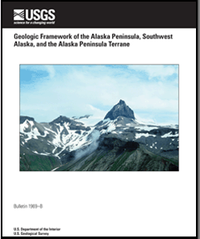Geologic framework of the Alaska Peninsula, southwest Alaska, and the Alaska Peninsula terrane
Links
- More information: USGS Index Page
- Document: Report (2 MB pdf)
- Plates:
- Companion File: Digital Data (html) Digital data for the Geologic Framework of the Alaska Peninsula, Southwest Alaska, and the Alaska Peninsula Terrane is available in USGS Open-File Report 99-317
- Download citation as: RIS | Dublin Core
Abstract
The Alaska Peninsula is composed of the late Paleozoic to Quaternary sedimentary, igneous, and minor metamorphic rocks that record the history of a number of magmatic arcs. These magmatic arcs include an unnamed Late Triassic(?) and Early Jurassic island arc, the early Cenozoic Meshik arc, and the late Cenozoic Aleutian arc. Also found on the Alaska Peninsula is one of the most complete nonmetamorphosed, fossiliferous, marine Jurassic sedimentary sections known. As much as 8,500 m of section of Mesozoic sedimentary rocks record the growth and erosion of the Early Jurassic island arc.
A thinner, but still thick (as much as 5,400 m), sequence of Tertiary sedimentary rocks that are predominantly continental overlies the Mesozoic section. A brief regression in early Tertiary time on the Alaska Peninsula and granodiorite plutonism in the Shumagin, Semidi, and Sanak Islands was followed by deposition of fluvial and minor marine clastic strata. This was followed by deposition of transgressive marine clastic strata and initiation of the Meshik arc, shown by an areally extensive outpouring of volcanic and volcaniclastic rocks and debris between late Eocene and earliest Miocene time. Late Miocene time was marked by another brief transgression and northwest- to southeast-directed compression, followed by renewed volcanism and plutonism which initiated the modern Aleutian magmatic arc.
Extensive glacial and glaciomarine deposits of late Pleistocene age create an extensive lowland physiographic province on the northwest side of the Alaska Peninsula and join isolated mountain masses to the Alaska Peninsula on the southwest. Multiple active volcanoes and volcanic peaks dominate the skyline of the Alaska Peninsula and represent the continuation of magmatic activity that has formed the Aleutian arc since late Miocene time.
The Alaska Peninsula has had a long and involved history since Paleozoic time. We propose that the Paleozoic and Mesozoic rocks that constitute much of the Alaska Peninsula be called the Alaska Peninsula terrane. Using the concept of subterranes, we divide the terrane into two distinct but tectonically related subterranes: the Chignik and Iliamna subterranes, which share a limited common geologic history. The Iliamna subterrane has served at most times as a source area for the Chignik subterrane; however, some rock units are in common across the subterranes. The Iliamna and Chignik subterranes are in part separated by the Bruin Bay fault system. The Iliamna subterrane is composed of moderately deformed early Mesozoic marine sedimentary and volcanic rocks and schist, gneiss, and marble of Paleozoic(?) and Mesozoic age, and plutonic rocks of the Alaska-Aleutian Range batholith. Characteristic of the Chignik subterrane are little-deformed, shallow-marine to continental clastic sedimentary rocks ranging in age from Permian to latest Cretaceous. However, deep-marine, volcaniclastic, and calcareous rocks form important components of the older rocks in the subterrane.
The two subterranes of the Alaska Peninsula terrane are characterized by radically different structural and metamorphic styles. The nonplutonic rocks of the Iliamna subterrane are characterized by metamorphism up to amphibolite-facies grade and intense folding. In the Chignik subterrane, the structural style is dominated by large, open, en echelon anticlinal structures, normal faulting, and thrust and high-angle reverse faults that have minor displacement in a northwest to southeast direction. In the Outer Shumagin and Sanak Islands, rocks assigned to the Chugach terrane are characterized structurally by tight, generally northeast-trending folds. Dips in these rocks tend to be steep, rarely less than 35°, and overturned beds are locally common.
The boundaries separating the Alaska Peninsula terrane from other terranes are commonly indistinct or poorly defined. A few boundaries have been defined at major faults, although the extensions of these faults are speculative through some areas. The west side of the Alaska Peninsula terrane is overlapped by Tertiary sedimentary and volcanic rocks and Quaternary deposits.
Study Area
| Publication type | Report |
|---|---|
| Publication Subtype | USGS Numbered Series |
| Title | Geologic framework of the Alaska Peninsula, southwest Alaska, and the Alaska Peninsula terrane |
| Series title | Bulletin |
| Series number | 1969 |
| Chapter | B |
| DOI | 10.3133/b1969B |
| Edition | Legacy Report |
| Year Published | 2015 |
| Language | English |
| Publisher | U.S. Geological Survey |
| Publisher location | Reston, VA |
| Contributing office(s) | Alaska Science Center |
| Description | Report: iii, 34 p.; 2 Plates: 57 x 44 inches and 31.5 x 32.77 inches; Digital Data |
| Country | United States |
| State | Alaska |
| Other Geospatial | Alaska Peninsula |
| Online Only (Y/N) | Y |
| Additional Online Files (Y/N) | Y |


